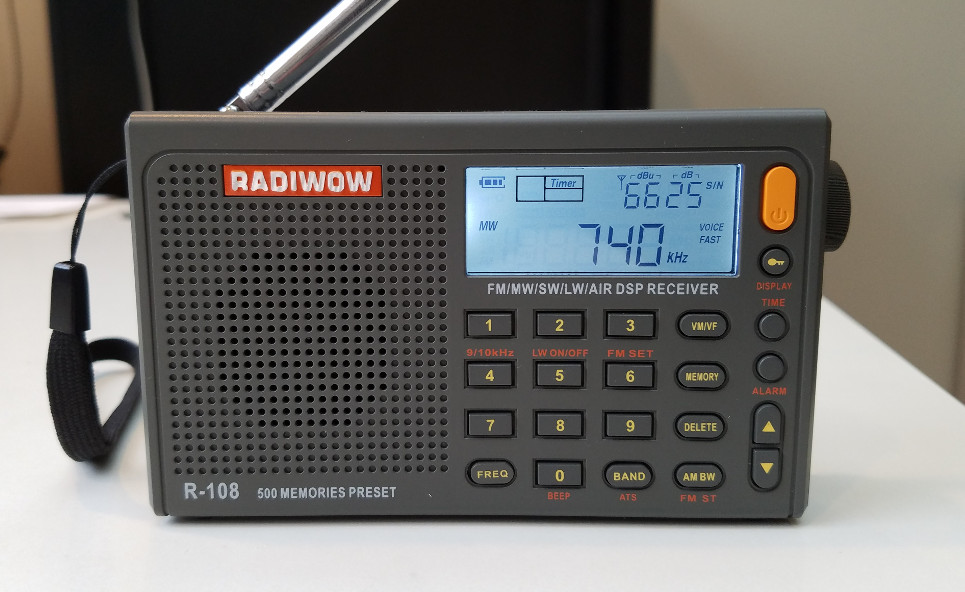
Released in late 2018, the Radiwow R-108 gained notice very quickly, thanks to some clever marketing in social media by the company that's selling the radio. It also became a bit notorious due to its resemblance to the CC Skywave in certain respects. But, in other ways, it seems to be quite a different radio than the C. Crane product, in some ways improving on the C. Crane offering.
The provenance of the radio is related to the XHDATA D-808, as shown by the XHDATA radio owner's manual, which gives Skype, email, and web addresses for radiwow.com. The website, of the Dongguan Ruidiao E-Commerce Company Ltd., prominently features the D-808, but rather less noticeably features the Radiwow R-108. In any event, the consensus seems to be that these radios are at least marketed by the same company. While the XHDATA was, at one time, difficult to obtain in the United States, the Radiwow R-108 can be ordered from Amazon. That's where I got mine, for just over $50. The radio was delivered two days after I ordered it. I didn't pay for two-day shipping, but that's what happened...on a Sunday, no less!
There have also been multiple reports of quality-control problems, such as odd ticking noises and other forms of digital interference. Yet others report few if any such problems. The unit that I bought seems mostly free from defects, with the only verified digital noises being those that result from pressing the keys on the unit. While not desirable, this is also not an uncommon phenomenon of digitally-tuned radios. A little more shielding should have been employed to prevent those key-press noises.
Others (such as the SWLing Post) have reported that their Radiwow units have digital hash (or "birdies") that shows up at 1200 and 1600 kHz and possibly also 800 kHz on the AM dial. I have heard those noises on this radio, but on other digitally tuned radios and on fully analog radios as well. The Radiwow appears to be no worse than other radios in these respects. The noise varies depending upon where I am in my residence. It seems worse on the top floor. There are solar panels on the roof and a power inverter outside, as well as a "smart meter" from the local utility. Those could be sources of interference, but I haven't been able to isolate the most likely cause of the noise. In any event, I feel that I can conclude that the Radiwow unit that I have is mostly free of digital interference. The varying reports about interference, though, raise concerns about quality control.
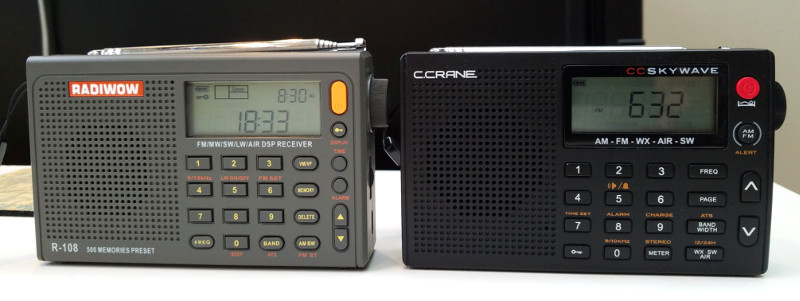
Knock-offs of prominent radio models are nothing new, but in the 1960s usually meant that the knock-off was of lower quality than the original. Even if we accept the proposition that the R-108 is a knock-off of the Skywave, the differences in quality are now small and often favor the Radiwow, with the main risk now being problems in quality control. The risk can be managed through buying from a seller with a clear return policy, such as Amazon. Someone buying this radio from an eBay seller not based in the United States will be taking more risks of getting a unit that performs suboptimally.
Late in the summer of 2020, the Sihuadon R-108 radio showed up on Amazon. Other than having a black case rather than dark gray, it appeared exactly the same as the Radiwow R-108, also priced for just over $50. The description of the radio was clear about its resemblance to the Radiwow R-108: "The performance of SIHUADON R108 radio is the same as the Radiwow R108 radio." (Viewed on amazon.com, September 7, 2020). The relationship between Radiwow (or XHDATA) and Sihuadon wasn't clear to me at the time. Noted "ultralight" radio enthusiast and DXer Gary DeBock reports that these radios are all from the same company.
What about the radio itself? It's the same size as the CC Skywave, as well as possibly related units such as the Digitech AR-1733 and the Elpa ER-C57WR. The shape is chunky, but the unit is stable, thanks to two rubberized feet on the bottom surface. The telescoping antenna, for all bands except AM and longwave, is 19 inches long, shorter than ideal for FM reception. The radio could be an even better FM performer with a correctly-sized 30-inch antenna, but it seems that the Chinese manufacturers are not taking that into account.
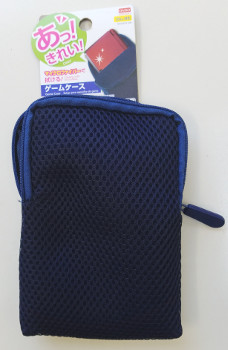
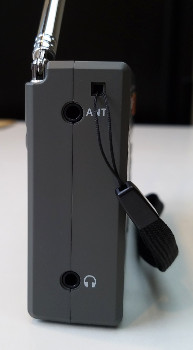
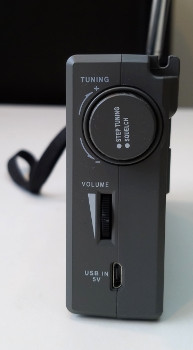
The radio itself comes packaged with a USB cord for charging and a plug-in antenna, intended primarily for use on shortwave, to be plugged into an antenna jack on the left side of the unit. That antenna jack also can be used for FM reception. On that same side is a stereo headphone jack. The right side has the tuning knob, an analog volume control, and a micro-USB jack (unlike the mini-USB jack used on some Tecsun models and the CC Skywave).
Earbuds are not included, which is no great loss; nor is a carrying case provided. I found a reasonable substitute for a carrying case at the Japanese discount store Daiso in San Francisco for $1.50 (right).
A BL-5C lithium-ion battery, fairly common in some cellphone brands, is included. Installing the battery requires an extra measure of care, because the upper right corner of the battery compartment door is behind the flip-up stand for the radio (see below right). In order to open the battery door without breaking anything, you first have to flip up the stand. I suppose the thinking here was that the battery wouldn't have to be changed often on the radio, compared to radios in which non-rechargeable batteries were used. Still, it's an awkward design.
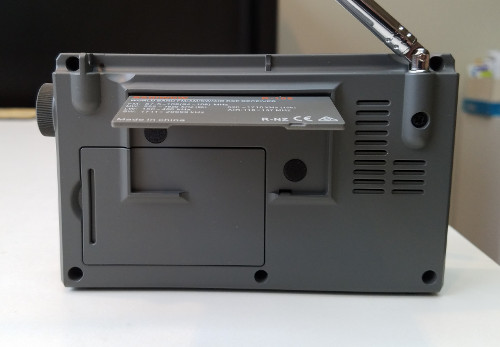
I am also not a fan of lithium-ion batteries in radios, particularly for a radio marketed as a travel radio. Lithium-ion batteries cannot travel in checked luggage. Thus, in order to travel with this radio, you'll have to bring it in your carry-on luggage. Even then, some airlines might look at this radio with some suspicions as a result of the type of battery it's using. In my opinion, this is a major detriment for the R-108, and one that could have been avoided.
Options for tuning stations on the R-108 sometimes work quite differently from similar radios. By default, the tuning knob on the right side of the unit can be used to move step-by-step through a radio band, which is what you'd expect. Briefly pushing in that knob switches between "fast" tuning and "slow" tuning in smaller steps. Direct frequency entry on the numeric keypad, prefaced by pressing the FREQ key, is common to other radios. The FREQ key is, in my opinion, in a handier location on the keypad (lower left on the keypad) compared to the CC Skywave (where it's at the upper right, the location of the VM/VF key on the Radiwow unit).
Unusually, memory presets are not accessed directly from the numeric keypad. They are instead accessed by first pressing the VM/VF key and then turning the tuning knob to go up or down through the presets. At the same time, the two up-and-down buttons at the right edge of the radio can still be used to tune stations step-by-step. The Radiwow approach appears to be a combination of using a Tecsun radio in VM mode and the frequency-entry approach of the XHDATA D-808 and the CC Skywave radios (i.e., pressing the FREQ button before entering the frequency). If you use the automatic scanning function to store stations into memory, you can have something very similar to Tecsun's Easy Tuning Mode (ETM), even though it's not a separate bank of memory.
The display has a bluish-white backlight similar to the XHDATA D-808, but a layout very reminiscent of the Tecsun PL-310ET.
Band selection is also different than most radios of this type, which have separate pushbuttons to select each band. The Radiwow uses a single BAND button to cycle through these choices, in order: FM, longwave (if turned on), AM, aviation (air) band, shortwave.
The quality of the sound from the built-in speaker is astonishing for its size. The speaker diameter is just 1 3/8", even smaller than the CC Skywave, but has a much beefier sound. When you first turn on the radio, it's that sound that you will notice. It's still not hi-fi, but there's more of a lower end than usual for these radios. The voice "filter" can help even more, on all bands, by de-emphasizing higher frequencies. Gary DeBock has reported that the radio packs a 3-watt amplifier, beefier than many other radios in this category. Definitely that would contribute to the audio quality. Gary has disassembled the R-108 model and found that the speaker was contained within its own enclosure, which also contributes to the sound quality. (See Gary's 2021 Ultralight Radio Shootout, for details and photographs). In any event, the sound is a big step up from the tinny sound of the CC Skywave, or of most Tecsun radios.
When using the headphone jack, an odd quirk became apparent on the unit that I have. The jack supports stereo sound on FM, but on my R-108, the left and right channels are mildly out of balance - favoring the left channel. This could be a minor quality control problem. It is slightly disconcerting, but not enough of a defect to cause me to reject the radio.
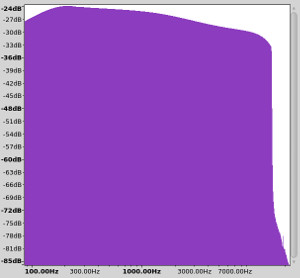
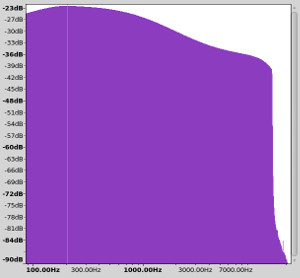
A voice/music "filter" is provided, toggled by pressing and holding the 4 key on the keypad. This functions somewhat like, but not exactly like, a high-cut tone control. The graphs above (music setting at left, voice setting at right) were taken with a sweep tone feeding an FM signal to avoid any effects from the AM or shortwave bandwidth selections. Comparing the frequency response curves between the two positions indicates that frequency response in the voice position starts down 2 dB at 1 kHz, then 3.5 dB at 2 kHz, 5.5 dB at 4 kHz, and 6 dB at 6 kHz, leveling out from that point through the rest of the audio spectrum (up to 15 kHz in the case of FM).
On the AM and shortwave bands, the sound can be further tailored through a choice of five bandwidths: 6, 4, 3, 2, or 1 kHz. This set of choices is common to several other DSP radios as well, but skips over three additional options (compare to the XHDATA D-808 or Digitech AR-1780, which offer all eight possible bandwidths from the Silicon Labs chips at the heart of these radios' components).
What about the radio's performance as far as reception is concerned? I care most about FM reception, but also check for AM reception. I compared the R-108 with four other units: the CC Skywave, the Digitech AR-1780 (nearly identical to the XHDATA D-808), the Tecsun PL-310ET, and the Tecsun PL-380. A 4 kHz IF bandwidth was used.
On the AM band, all were very close, with the CC Skywave having a slight edge starting at about 1290 kHz, especially noticeable on 1440 kHz, where it got a better quality signal from Napa's KVON than the rest. On the other hand, the Digitech was able to receive, weakly, KRRS at 1460 kHz from Santa Rosa, which none of the other radios could receive. So any differences between the five radios are minor.
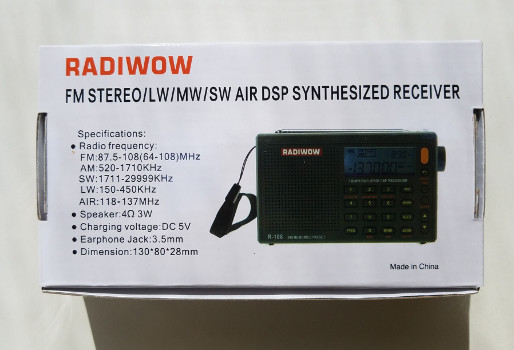
On the FM band, as in previous head-to-head comparisons, the Tecsun PL-380 performed the best. Despite its far too short antenna, the Radiwow was almost as good. But the Tecsun could get a few stations to lock into stereo that most of the others couldn't. Directly comparing the Radiwow R-108 with the CC Skywave, the Skywave was just a touch better in the lower part of the FM band, while the Radiwow was better at the middle of the band and above. The bandwidth of the CC Skywave also seemed wider than the rest, with slightly less rejection of adjacent-channel signals being the result.
With these results, I think it's fair to say that the Radiwow R-108 may have taken some inspiration from the CC Skywave, enough that some might consider it a knock-off. Still, the sound quality of the R-108's speaker is a big step up, FM performance is slightly improved compared to the Skywave, and I like having an external antenna jack. On the other hand, I do not like the fact that the Radiwow uses a lithium-ion battery. The battery may also not have enough capacity to support extended listening sessions. (Thanks to Gary DeBock for this observation in his 2021 Ultralight Radio Shootout.) The Radiwow also lacks weather-band reception, which is relevant only in North America. If you get a properly functioning unit, and you don't plan to travel with it, then the Radiwow R-108 can be a good choice, especially if sound quality from the built-in speaker is important to you.